Victorian Fish-Scale Embroidery
By using a variety of colored fish-scales, exquisite borders and designs could be made. |
 |
Beneath a layer of cherished memories packed deep in an old attic trunk was found a picture of buds and blossoms with their lovely opalescent coloring suggesting, but for their transparency, the changing light of mother-of-pearl. Flowers such as lily-of-the-valley, clematis (a colorful perennial), marguerites (a golden daisy-like flower), and great double roses gleamed out from the dark crimson velvet that formed so warm a background. A tiny card, tucked away at one corner of the back, told us the story of the piece; how well over a century ago, when the boys in blue were fighting the boys in gray, one brave woman, with more time than money, sold this lovely creation for the benefit of the wounded with which the hospitals during the Civil War were filled. Without this note, we might never have imagined that the deft fingers and artistic eye of the embroiderer had only the scales of the common shad to work with — this treasured work of art was created with fish-scales. |
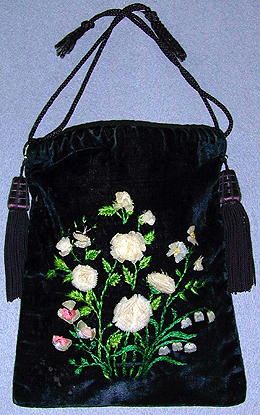 |
| Fish Scales Reticule (front), c1830s. [Photo: Meg Andrews] |
This unique manner of embroidery was a novelty during the nineteenth century and its exquisite effects cannot be realized without seeing an actual hand-worked specimen. This article presents two velvet reticules from the 1830s to illustrate this unusual art. By using a variety of colored fish-scales, very effective borders and designs could be made, which were utilized in a variety of articles of fancy work. Mantel draperies, cushions, borders for table covers, scarves, and purses were often ornamented with this peculiar, but striking type of needlework at a negligible cost. |
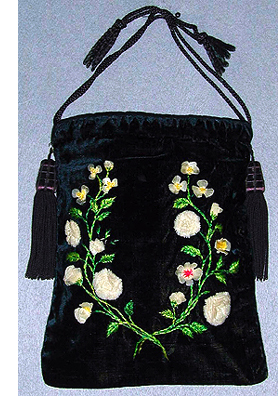 |
| Fish Scales Reticule (back), c1830s. [Photo: Meg Andrews] |
The most suitable backgrounds for the opalescent tint of fish-scales were velvet, velveteen, plush, satin, or silk, in various shades of green, blue or pink. On these materials a great many plant forms, with their blossoms and berries—such as ferns, sprays of forget-me-nots, single brier roses, and clusters of full double roses, any wheel or star-shaped flowers — were imitated in fish-scales, as well as butterflies and hummingbirds. |
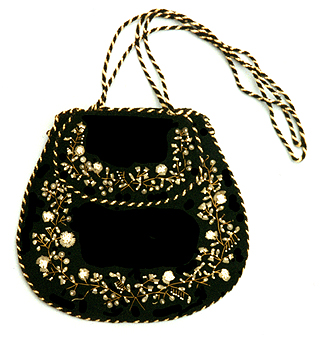 |
| Fish-scale reticule, c1830s. |
The best scales were those of brilliant iridescent hues with deep serrations, such as could be found in the perch and in some varieties of carp. Other type fish-scales that were beautiful were also utilized, amongst them the luminously colored scales of the common goldfish. The most brilliant coloring, or rather iridescence, was found in the female; the scales were larger too, and in some flowers that was an important consideration. |
Typically the scales were prepared while quite fresh by cleansing them thoroughly, or, if necessary, by soaking them in clear water until soft and pliable. The fishy smell would pass off entirely, and the thin membrane would roll up, only adhering at one side of each scale. The forms of the scales were astonishingly varied — some irregularly edged like a rose petal in miniature, others a trifle jagged and fringed, suggesting apple blossoms — but all were most exquisitely transparent. Each scale was then perforated near its base with two minuscule punctures by a darning needle. To enhance the design, a little varnish mixed with a very moderate portion of various colors was sometimes added to touch up the scales. Borders to various articles in fish-scale work were made by arranging scales in rows, each scale cut in the form of a semicircle, then fastened with a French knot or a bead in the center, and then strands of silk were passed through a hole in the base, and from this out over the edge like rays. |
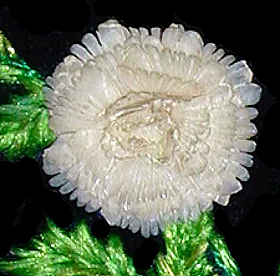 In making marguerites, or other flowers of star-like shape, the scales were first sewn round the outer edges of the tracing prepared on the material, repeating the circles in gradually diminishing sizes until the center of the flower was reached. The center was often finished with a cluster of French knots in a suitably colored silk, or by ornamental glass or metal beads. The leaves were formed by sewing the scales flatly upon each side of the mid rib, which, like the stems and veins of leaves, were worked in stem or outline stitch with green silk. Small leaves were made by cutting the fish-scales into the required shape with sharp-pointed scissors. When simple scales were used it was not possible to hide the stitches; therefore, after passing a needle threaded with silk through a hole in the center of the base, it was then carried straight to the end, and passed downward through another hole, and, if necessary, two or three side veins of the leaves were made in this manner. |
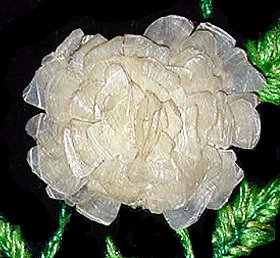 Roses would be worked from the inside by first fastening a ring of the smallest scales around a center of French knots or pearl beads. Then selecting larger scales, the outer rows were arranged and opened outward along the edge of the rose, making one row overlap the other, so as to conceal the stitches by which they were attached. In making a hummingbird, the best colored and brightest scales would be fastened upon the breast and neck, allowing each scale to fold neatly over the one preceding it until the whole was covered. For the extended wings and curved tail the scales would be applied in the form of long feathers which was best effected by sewing them first on strips of narrow satin ribbon arranged a little slanting down each side of a central thread of embroidered silk — green, blue, crimson, purple — varying the color in each one. The beak, legs, claws, and a few of the feathers would be worked with silk of the same colors. The eye of the bird was formed by a single bead. |
Create your own fish-scale project!
A Victorian Needle-Book, c.1866 Materials — A strip of perforated cardboard, nine inches long and four and a half inches wide; a piece of red silk ribbon of the same dimensions; two and a half yards of red ribbon, half an inch wide; red sewing-silk; white flannel; fish-scales. Instructions: This needle-book is composed of two stars, covered with small fish-scales and bound round with a quilling of ribbon. Fig. 1 shows the pattern in full size. Each star is cut out of a piece of perforated card-board 4 ½ inches square, over which a circle is traced measuring 4 ¼ inches across. Now divide the circle into eight notches ¾ inches deep, and cut them out; cover both the star-shaped pieces with fish-scales, which should previously have been well washed in hot salt water and carefully wiped and dried. Next line both the pieces of cardboard with the red ribbon 4 ½ inches wide, and on the side of the lining sew on a quilling of the narrow ribbon so as to let it show a little beyond the edge on the right side. Place two pieces of fine white flannel inside the pieces of cardboard for holding the needles; cut them out of the same shape, but rather small. Join both sides of the cover by sewing a small piece of ribbon over one notch of each star, forming a sort of hinge; then sew a piece of ribbon, six inches long, to two notches on the opposite side, which serve to fasten the needle-book by a bow. |
|
Sources: Images: Courtesy of Meg Andrews. Visit the Meg Andrews web site specializing in English Costume and accessories from the 18th and 19th centuries; Shawls from the late 18th c - 1860 including shawls of Paisley design; English samplers and silkwork pictures; document and decorative fabrics, both woven and printed; English Arts and Crafts embroidered, woven and printed textiles; Chinese court costumes and accessories; and European textiles. |

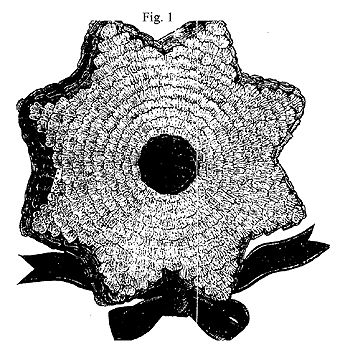
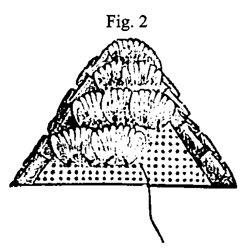 The needle, threaded with red silk, is inserted in the lower
part of the scales to fasten them on to the cardboard as
seen in Fig. 2, which gives a part of the pattern during the
process of working. The indented edge of the scales should
be placed upwards, and they should overlap each other.
Cover in this way the eight notches first, and then the rest
of the stars, arranging the scales in regular circles, and
only leave a small space in the center, in which place a
rosette of red ribbon.
The needle, threaded with red silk, is inserted in the lower
part of the scales to fasten them on to the cardboard as
seen in Fig. 2, which gives a part of the pattern during the
process of working. The indented edge of the scales should
be placed upwards, and they should overlap each other.
Cover in this way the eight notches first, and then the rest
of the stars, arranging the scales in regular circles, and
only leave a small space in the center, in which place a
rosette of red ribbon. 